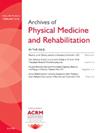同步与非同步远程康复方案对慢性非特异性腰痛的影响:一项三组随机对照试验。
IF 3.7
2区 医学
Q1 REHABILITATION
Archives of physical medicine and rehabilitation
Pub Date : 2025-09-01
DOI:10.1016/j.apmr.2025.05.012
引用次数: 0
摘要
目的:本研究旨在评估同步和异步远程康复治疗CNLBP的有效性。设计:三组平行随机试验设置:大学医院骨科与创伤科受试者:该随机对照试验共72例(女性31例,男性41例;平均年龄41.26±10.97岁)。干预措施:参与者被随机分为三组:同步远程康复组(STG) (n = 24)、异步远程康复组(ASTG) (n = 24)和对照组(CG) (n = 24)。一个结构化的锻炼计划通过预先录制的视频实时传递给STG,通过电子书传递给CG(12周)。主要结果测量:使用视觉模拟量表(VAS)测量疼痛水平作为预先指定的主要结果。采用Roland Morris残疾问卷(RMDQ)和Oswestry残疾指数(ODI)进行残疾评估。使用坦帕量表(TSK)评估运动恐惧,使用SF-12评估生活质量。结果:疼痛水平、残疾状况、运动恐惧和生活质量在第12周均有改善(结论:实时同步远程康复计划在改善疼痛、残疾、运动恐惧和生活质量方面优于异步组,而与无监督家庭锻炼计划相比,异步组仅在改善生活质量方面优于无监督家庭锻炼计划。这些结果表明,远程治疗可以在临床实践中引入,以改善患者的治疗效果和资源利用,并最终得到更广泛的应用。本文章由计算机程序翻译,如有差异,请以英文原文为准。
Effects of Synchronous Versus Asynchronous Telerehabilitation Programs for Chronic Nonspecific Low Back Pain: A Three-Arm Randomized Controlled Trial
Objective
To assess the effectiveness of synchronous and asynchronous telerehabilitation programs in managing chronic nonspecific low back pain (CNLBP).
Design
A three-arm parallel group randomized trial
Setting
University Hospital, Department of Orthopedics and Traumatology
Participants
This randomized controlled trial was carried out on individuals (N=72) (31 women, 41 men; mean age, 41.26±10.97y) with CNLBP.
Interventions
Participants were randomly assigned to 3 groups: (1) a synchronous telerehabilitation group (STG) (n=24), (2) an asynchronous telerehabilitation group (ASTG) (n=24), and (3) a control group (CG) (n=24). A structured exercise program was delivered in real-time to the STG via prerecorded videos to the ASTG and through a digital book to the CG (12wk).
Main Outcome Measures
Pain levels as the prespecified primary outcome were measured using the visual analog scale. Disability was assessed with the Roland Morris Disability Questionnaire and Oswestry Disability Index. Fear of movement was evaluated with the Tampa Scale, and quality of life was determined using the SF-12.
Results
Pain levels, disability status, fear of movement, and quality of life showed improvement at week 12 in all groups (P<0.05). In addition, the STG showed greater improvements than the CG in the visual analog scale (mean difference, 1.28; 95% CI, 0.50-2.05). Moreover, the ASTG obtained more significant results than the CG group only in the subparameters of SF-12 (physical component summary and mental component summary).
Conclusions
A real-time synchronous telerehabilitation program was superior in improving pain, disability, fear of movement, and quality of life, whereas the asynchronous group was superior compared with an unsupervised home exercise program in improving quality of life only. These results imply that remote therapy could be introduced in clinical practice to improve patient outcomes and resource utilization and eventually be used more broadly.
求助全文
通过发布文献求助,成功后即可免费获取论文全文。
去求助
来源期刊
CiteScore
6.20
自引率
4.70%
发文量
495
审稿时长
38 days
期刊介绍:
The Archives of Physical Medicine and Rehabilitation publishes original, peer-reviewed research and clinical reports on important trends and developments in physical medicine and rehabilitation and related fields. This international journal brings researchers and clinicians authoritative information on the therapeutic utilization of physical, behavioral and pharmaceutical agents in providing comprehensive care for individuals with chronic illness and disabilities.
Archives began publication in 1920, publishes monthly, and is the official journal of the American Congress of Rehabilitation Medicine. Its papers are cited more often than any other rehabilitation journal.

 求助内容:
求助内容: 应助结果提醒方式:
应助结果提醒方式:


